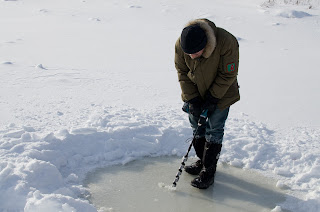Sorry for not keeping up to date, it's been a busy week.
The hut was erected last weekend on site at The Forks. Throughout the week it has received several coats of water, which have now frozen into ice.
 |
| Photo: Matthieu Léger |
The fibre glass pieces and the rest of the components were transported to the site on Saturday morning. After moving the components to the ice, the structural bays were put in place.
 |
| Photo: Matthieu Léger |
At first, we attempted to lay the entire structure flat, clamp each connection, and then raise the pieces to stand upright. However, due to the lack of friction on the ice, it was too difficult to adjust the structure correctly before clamping it in place. Instead, we opted to construct the hut as we had originally tested outside on numerous occasions.
 |
| Photo: Matthieu Léger |
 |
| Photo: Matthieu Léger |
 |
| Photo: Matthieu Léger |
 |
| Photo: Matthieu Léger |
 |
| Photo: Matthieu Léger |
Once the structure was in place, the fabric had to be threaded through the tips. This was quite the experience! By flattening the structure we were able to bend it horizontally, enough to fit the fabric over the tips. Then, starting at one end, the fibreglass bays were returned their positions and re-attached to the rebar.
 |
| Photo: Matthieu Léger |
 |
| Photo: Matthieu Léger |
 |
| Photo: Matthieu Léger |
 |
| Photo: Matthieu Léger |
 |
| Photo: Matthieu Léger |
 |
| Photo: Matthieu Léger |
 |
| Photo: Matthieu Léger |
After a week of watering the building, the Cocoon team is excited for the opening this weekend!
with text from Kailey Kroeker
































